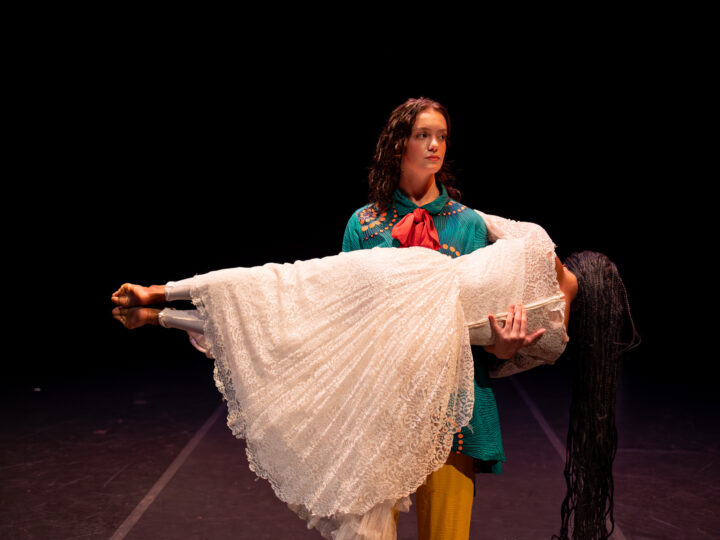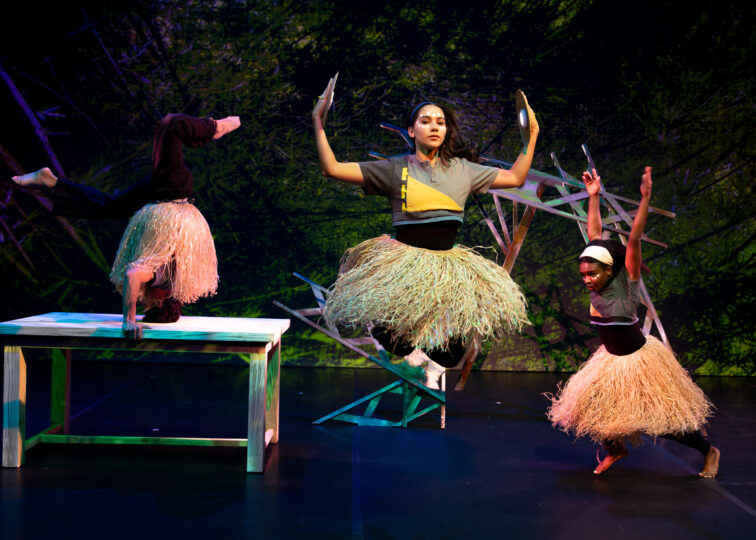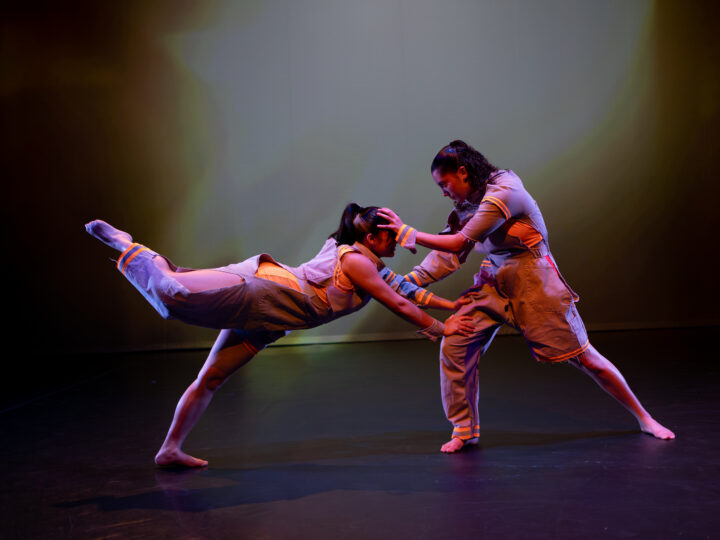Dance Repertory Theatre’s Rooted in Motion is a tapestry of original choreographic works, transporting audiences to four unique worlds. Each choreographer has their own specific aesthetic influences and dance backgrounds, expanded and emphasized by their dancers, designers and creative teams. The pieces in this dance concert investigate the power and comfort of community and the ever-evolving realization of our inner selves. They look towards the future while uncovering the past. Between the four pieces, they pull from hip hop, jazz, ballet, post-modern and Nigerian dance forms and styles. We spoke with choreographers Makaila Natividad, Vanessa Anspaugh, Sinclair Emoghene and EG Gionfriddo to understand the distinct processes and influences behind the works on stage as part of Rooted in Motion.
Ohr
Choreographed by Makaila Natividad
From the choreographer: “Ohr (pronounced or) — light. What happens when light meets darkness? Shadows recede, edges soften and what once was hidden is revealed. Light shines in the darkness, and the darkness has not overcome it. This piece comes from a place of finding freedom in the uncomfortable, fractured process of unveiling—of what is revealed, reshaped and made whole in the light.”
What dance forms and styles inspired you when choreographing this piece?
Natividad: “I’m very inspired by contemporary fusion works influenced by hip hop, ballet and jazz—specifically by artists like Paris Cavanagh and works by Ballet BC—because of the intensity they create. These styles have greatly influenced my dance career, and they naturally blend into my own choreography, especially in this process, creating contrasts that I feel match the story it tells.”
What discoveries were made during rehearsals that influenced the creation of this piece?
Natividad: “This time around with my choreographic process, I discovered a deeper focus on ensuring that both dance excellence and the intention behind the piece’s “why” were equally important. Not that they weren’t before, but approaching choreography in this process has shifted my priorities—focusing not only on my own understanding as the choreographer, but also on helping my dancers find that meaning within themselves and the piece.”

Wild Hearts and Other Ecologies
Choreographed by Vanessa Anspaugh (in collaboration with the dancers)
What dance forms and styles inspired you when choreographing this piece?
Anspaugh: “I wouldn’t say that there were specific dance styles or forms that specifically inspired the making of the piece. The people, the cast in this work, each of them and their various movement backgrounds and personal lived histories, interests, strengths, struggles and how those qualities live in their bodies are what inspired the style of movement. Additionally, you can see influences from various dance forms such as, jazz, ballet, hip-hop, modern and post-modern dance. From my perspective, the postmodern / experimental dance aesthetic holds all movement forms as influence and possibility along with ease and efficacy of movement on the body. It can embrace the pedestrian, as well as the virtuosic, thus a kind of umbrella term for the work to potentially live inside of.”
What discoveries were made during rehearsals that influenced the creation of this piece?
Anspaugh: “So many discoveries were made in rehearsals! Andrea, Leli, Jermey, Jalissa, Haley, Julia, Brilley and Cassidy are each exquisite gemstones of various textures and tones– what happens when they can see one another? What kind of light is reflected through the space and through their bodies? How can their collective brightness be shared with an audience so that we can see the individual in the collective? They can care about their own selves and voices even better when they hold and uplift one another; what they are carrying, the weight of atrocity and what they have inherited from the culture, doesn’t have to be held alone. What do we share that we are holding? What do we want to let go of and what do we want to keep? What does cement actually feel like to your fingertips? Aliveness is an ongoing practice in waking up in each moment- to sensing, feeling and continuing to care.”

Mé Duniya
Choreographed by Sinclair Emoghene
From the Choreographer: “Mé Duniya (Hausa for “what is life?”) investigates the futility of existence and the complexities of telling history. Choreographed through theatricality, unconventional movement, sonicscapes and imagined embodied transmissions, the work envisions a cold, drained planet where events never align—an exploration of reverse-dystopianism. Set 450 years in the future, it attempts to reconstruct fragmented pasts, asking how intelligent beings without clear recollections can situate origins to make sense of their world. “
What dance forms and styles inspired you when choreographing this piece?
Emoghene: “In creating this piece, I drew inspiration from several Nigerian dances: Ekombi and Abang (Efik/Ibibio), Akoto (from Badagry in Lagos State), Swange (a social dance of the Tiv people in Benue State) and Ema, Achikoro and Udje (Urhobo and Igbo dances from Southern Nigeria). Over the past decade, I have cultivated a choreographic practice that blends these forms into what I describe as hybrid traditional dances, works intentionally designed for concert performance arenas such as those here at UT Austin. This piece emerges from the convergence of the dances carried in my body that reflect the ways they have fused, evolved and reshaped themselves through my experience of living and creating in the United States and dancing other western styles.”

VOID / ing
Choreographed by EG Gionfriddo
What dance forms and styles inspired you when choreographing this piece?
Gionfriddo: “VOID/ing, a variation of a larger work for my company ARCOS, was inspired by two main sources: my pre-pandemic archive of unrealized projects and my body in the present, dealing with chronic pain. The contrast between these two selves created the tension and cathartic release in the piece.”
What discoveries were made during rehearsals that influenced the creation of this piece?
Gionfriddo: “Creating three distinct iterations of VOID simultaneously (with ARCOS, Dance Repertory Theatre and Texas State University students) clarified one primary method: committing to the specificity of physicality is what produces emotion, rather than the other way around.”
Rooted in Motion
November 13 – 21, 2025
Oscar G. Brockett Theatre
TICKETS

